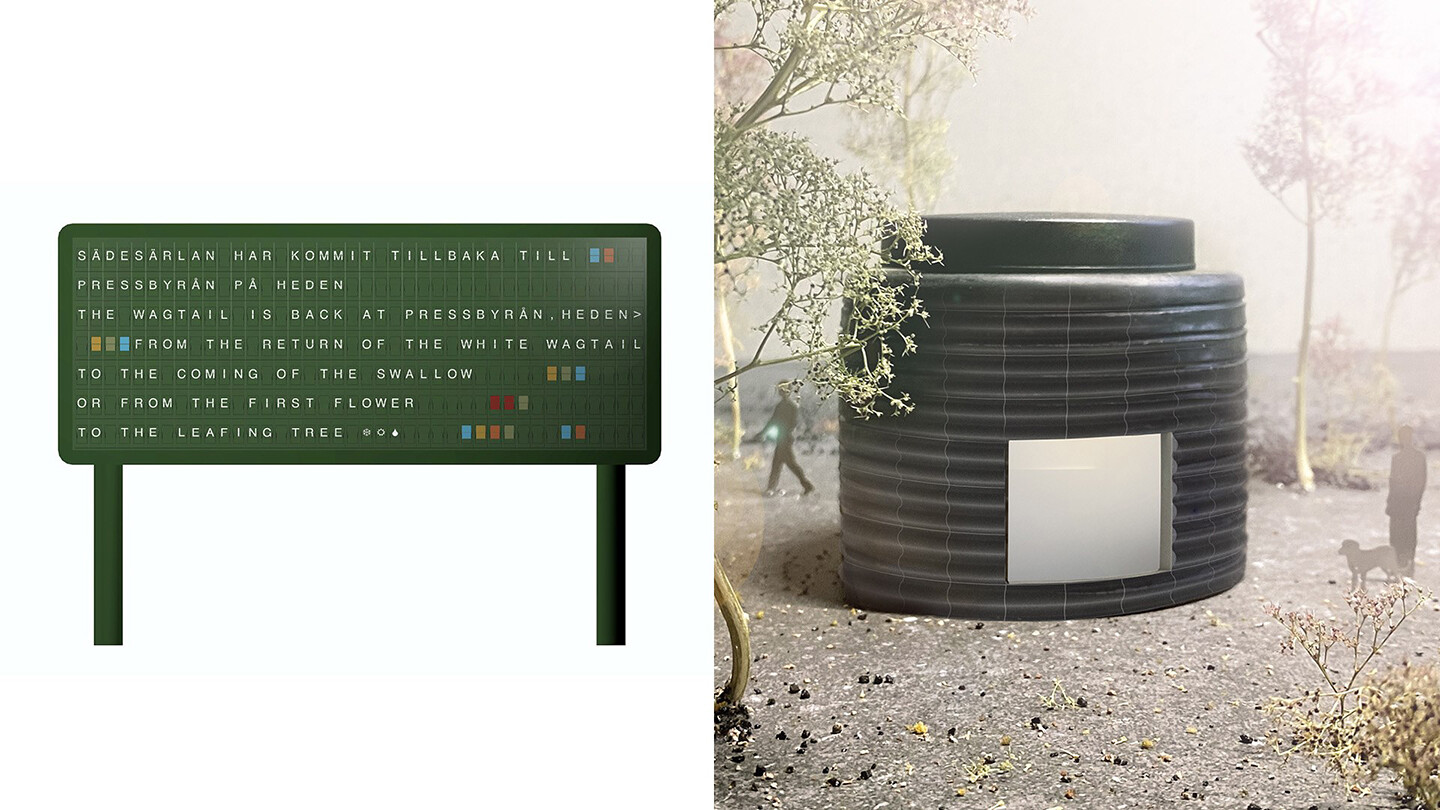The artistic proposals “Everything Must Change” by Ruth Ewan and “Pitch Drop Pavilion (700 Years)” by Nina Canell have been selected as the winners of the international competition Public Art for the Urban Spaces around Haga and Korsvägen Stations in Gothenburg. The competition was organized by the City of Gothenburg within the framework for the West Link, a public development project that links together the city of Gothenburg and the surrounding region through an underground railway connection.
These art projects are going to make an impact on the public space of the city for many years to come. Both works succeed in the difficult and extraordinary challenge of taking on existential themes while at the same time being straightforward and open to the visitors who encounter them, says Sarah Hansson, Process Leader for Public Art at the City of Gothenburg.
Ruth Ewan: Everything Must Change
For the urban space around Korsvägen Station, Ewan will create an alternative perpetual time system that displays observations of shifts in nature such as events in animal and plant life. The “clock” shows cycles in nature as a contrast to the normal linear way of viewing time and is inspired by phenology and by Carl Linnaeus’s floral calendar. The work will take the form of several split-flap display boards of the kind that was once ubiquitous at airports and train stations.
A collection of texts
The boards will display time-specific observations submitted by Gothenburg residents, alongside quotations gathered from historical documents. As a collection of texts, they will reflect the shifts in nature throughout day and the seasons in the local urban environment.
I’m delighted to have been given the opportunity to develop this idea. I am looking forward to inviting people from all walks of life, all across the city to put forward their observations which will collectively form the content for the system, says artist Ruth Ewan.
Observations will be gathered over a period of one year, during which time the city’s inhabitants will be encouraged to observe and register events in the natural world around them. These may be observations of flowers that bloom at dinner time, a neighbor’s oak beginning to drop its leaves in September, sunlight and shadows falling across a kitchen table, or a baby waking up at a certain time every night.
A representation of time passing through nature
The split-flap display boards change their messages several times a day, and the content of those messages follows the cyclical changes in the natural world based on the subjective experiences of Gothenburg residents. The boards can show quotations from thousands of individuals and historical voices linked to the city. Thus, they will provide a pluralistic and lyrical representation of time passing through nature.
About the artist
Ruth Ewan (born 1980 in Scotland) is an artist based in Glasgow. She has a degree in drawing and painting from Edinburgh College of Art, and her work has been shown in many major institutions and biennials around the world. Ewan has a research-based practice which extends through the creation of dialogue-based processes. She often works with public space and questions of how social movements take form and spread from individuals to society.
Nina Canell: Pitch Drop Pavilion (700 Years)
In an existing green area adjacent to Haga Station, a process-based artwork will transform over time. A cylindrical pavilion turned sculpture will host a volume of pitch that gradually stretches and deforms. Pitch flows at a very slow rate, taking several years to form a single drop.
Pitch as a material
Pitch is a fossil material that is derived from decayed plants, resin, coal, or petroleum and has traditionally been used to seal boat hulls, among other things. It is an incredibly slow-flowing material, with a viscosity at least a billion times higher than that of water.
Through a funnel inside the pavilion, a drop of pitch will slowly form and eventually fall. If you’re lucky, you might be there to witness that rare moment. The exterior of the pavilion is clad with wave-formed cast basalt tiles whose light-reflecting and iridescent surface invites associations with mineral history and geology. The black pitch can be seen from a single window, and a ring of skylights floods the interior with natural light.
The Pitch Drop Pavilion is not so much about observing time as being in the presence of it. The creep of time bottled up, suspended in the present, while holding a yet contingent future moment within reach, says artist Nina Canell.
A study of waiting and time
The installation will remain untouched for at least 100 years, but there will be enough pitch to last as much as 700. In this way, Pitch Drop Pavilion (700 Years) can be seen as a dizzying study of waiting and time. The work invites its spectators to reflect on different concepts of time and biological and geological rhythms, and simultaneously visualizes the creep of time and challenges the often-stressful relationship to chronological time that otherwise characterizes train stations.
About the artist
Nina Canell (born in 1979 in Växjö) is an artist based in Berlin. She earned her degree in art from the Dun Laoghaire Institute of Art, Design and Technology in Dublin and has participated in multiple biennials and has had several solo shows at museums around the world. Her artistic practice does not revolve around the finished artwork; instead, it foregrounds process, synergy and transformation.
Everything Must Change and Pitch Drop Pavilion (700 Years) will be developed and implemented in the next few years within the framework of the Chronotopia art program. The artworks are to be installed in 2026, when the rest of the West Link project is completed.
For more information
See the open call for artists.
Read more about the West Link and the art program Chronotopia.
See the concept proposals for the urban space around Korsvägen Station.
See the concept proposals for the urban space around Haga Station.






